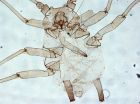(Press-News.org) Researchers at Northwestern University have created a robotic fish that can move from swimming forward and backward to swimming vertically almost instantaneously by using a sophisticated, ribbon-like fin.
The robot -- created after observing and creating computer simulations of the black ghost knifefish -- could pave the way for nimble robots that could perform underwater recovery operations or long-term monitoring of coral reefs.
Led by Malcolm MacIver, associate professor of mechanical and biomedical engineering at Northwestern's McCormick School of Engineering and Applied Science, the team's results are published in the Journal of the Royal Society Interface.
The black ghost knifefish, which works at night in rivers of the Amazon basin, hunts for prey using a weak electric field around its entire body and moves both forward and backward using a ribbon-like fin on the underside of its body.
MacIver, a robotics expert who served as a scientific consultant for "Tron: Legacy" and is science advisor for the television series "Caprica," has studied the knifefish for years. Working with Neelesh Patankar, associate professor of mechanical engineering and co-author of the paper, he has created mechanical models of the fish in hopes of better understanding how the nervous system sends messages throughout the body to make it move.
Planning for the robot -- called GhostBot -- began when graduate student Oscar Curet, a co-author of the paper, observed a knifefish suddenly moving vertically in a tank in MacIver's lab.
"We had only tracked it horizontally before," said MacIver, a recent recipient of the prestigious Presidential Early Career Award for Scientists and Engineers. "We thought, 'How could it be doing this?'"
Further observations revealed that while the fish only uses one traveling wave along the fin during horizontal motion (forward or backward depending on the direction on the wave), while moving vertically it uses two waves. One of these moves from head to tail, and the other moves tail to head. The two waves collide and stop at the center of the fin.
The team then created a computer simulation that showed that when these "inward counterpropagating waves" are generated by the fin, horizontal thrust is canceled and the fluid motion generated by the two waves is funneled into a downward jet from the center of the fin, pushing the body up. The flow structure looks like a mushroom cloud with an inverted jet.
"It's interesting because you're getting force coming off the animal in a completely unexpected direction that allows it to do acrobatics that, given its lifestyle of hunting and maneuvering among tree roots, makes a huge amount of sense," MacIver said.
The group then hired Kinea Design, a design firm founded by Northwestern faculty that specializes in human interactive mechatronics, and worked closely with its co-founder, Michael Peshkin, professor of mechanical engineering, to design and build a robot. The company fashioned a forearm-length waterproof robot with 32 motors giving independent control of the 32 artificial fin rays of the lycra-covered artificial fin. (That means the robot has 32 degrees of freedom. In comparison, industrial robot arms typically have less than 10.) Seven months and $200,000 later, the GhostBot came to life.
The group took the robot to Harvard University to test it in a flow tunnel in the lab of George V. Lauder, professor of ichthyology and co-author of the paper. The team measured the flow around the robotic fish by placing reflective particles in the water, then shining a laser sheet into the water. That allowed them to track the flow of the water by watching the particles, and the test showed the water flowing around the biomimetic robot just as computer simulations predicted it would.
"It worked perfectly the first time," MacIver said. "We high-fived. We had the robot in the real world being pushed by real forces."
The robot is also outfitted with an electrosensory system that works similar to the knifefish's, and MacIver and his team hope to next improve the robot so it can autonomously use its sensory signals to detect an object and then use its mechanical system to position itself near the object.
Humans excel at creating high-speed, low-maneuverability technologies, like airplanes and cars, MacIver said. But studying animals provides a platform for creating low-speed, high-maneuverability technologies -- technologies that don't currently exist. Potential applications for such a robot include underwater recovery operations, such as plugging a leaking oil pipe, or long-term monitoring of oceanic environments, such as fragile coral reefs.
While the applied work on the robot moves ahead in the lab, the group is pursuing basic science questions as well. "The robot is a tool for uncovering the extremely complicated story of how to coordinate movement in animals," MacIver said. "By simulating and then performing the motions of the fish, we're getting insight into the mechanical basis of the remarkable agility of a very acrobatic, non-visual fish. The next step is to take the sensory work and unite the two."
INFORMATION: END
MADISON — A cold dose of fear lends an edge to the here-and-now — say, when things go bump in the night.
"That edge sounds good. It sounds adaptive. It sounds like perception is enhanced and that it can keep you safe in the face of danger," says Alexander Shackman, a researcher at the University of Wisconsin-Madison.
But it sounds like there's also a catch, one that Shackman and his coauthors — including Richard Davidson, UW-Madison psychology and psychiatry professor — described in the Jan. 19 Journal of Neuroscience.
"It makes us more sensitive to our external surroundings ...
Collaborative research at the University of Guam has people asking: "What IS a species" and entomologists wondering about the relationship between an insect species and the host plant or plants it feeds on.
Western Pacific Tropical Research Center (WPTRC) entomologist Ross Miller has been studying aphids for years and this work has brought him in contact with entomologists in Canada and the US mainland. Aphid systemetist Robert Foottit, DNA expert Eric Maw and aphid authority Keith Pike have been working with Miller on the identification of aphids, particularly the dreaded ...
While the overall hospitalization rate for stroke has declined in recent years, the numbers have jumped dramatically for patients infected with human immunodeficiency virus (HIV), suggesting they may be up to three times more likely to suffer a stroke than people uninfected by the virus that causes AIDS.
In a paper published in the Jan. 19 online issue of Neurology, Bruce Ovbiagele, MD, professor of neurosciences at the University of California, San Diego School of Medicine and Avindra Nath, MD, of Johns Hopkins University, reviewed a national dataset of all hospital ...
ST. PAUL, Minn. – New research suggests that people infected with human immunodeficiency virus (HIV) may be up to three times more likely to have a stroke compared to those not affected with HIV. The study is published in the January 19, 2011, online issue of Neurology®, the medical journal of the American Academy of Neurology.
"Our findings showed that stroke hospitalizations in the United States decreased by seven percent in the general population within the last decade while stroke hospitalizations for people with HIV rose 67 percent," said Bruce Ovbiagele, MD, MSc, ...
Ohio State University entomologists have conducted the first genetic study of bedbugs, paving the road to the identification of potential genes associated with pesticide resistance and possible new control methods for the troublesome insect, whose sudden resurgence in the United States has led to a public health scare.
The discovery was reported Jan. 19 in the online journal PLoS ONE.
"While bedbugs are poised to become one of the major household pests across the United States in the coming years, we know very little about their genetic makeup and their mechanisms of ...
The secrets behind the mysterious nano-sized electromagnetic "hotspots" that appear on metal surfaces under a light are finally being revealed with the help of a BEAST. Researchers at the U.S. Department of Energy (DOE)'s Lawrence Berkeley National Laboratory (Berkeley Lab) have developed a single molecule imaging technology, dubbed the Brownian Emitter Adsorption Super-resolution Technique (BEAST), that has made it possible for the first time to directly measure the electromagnetic field inside a hotspot. The results hold promise for a number of technologies including ...
UCSF researchers have developed a new approach to decoding the vast information embedded in an organism's genome, while shedding light on exactly how cells interpret their genetic material to create RNA messages and launch new processes in the cell.
By combining biochemical techniques with new, fast DNA-sequencing technology and advanced computer technology, the team was able to examine with unprecedented resolution how a cell converts DNA into RNA – a molecular cousin of DNA that is used in the process of creating proteins that govern most biological functions. And they ...
The Orion Nebula, also known as Messier 42, is one of the most easily recognisable and best-studied celestial objects. It is a huge complex of gas and dust where massive stars are forming and is the closest such region to the Earth. The glowing gas is so bright that it can be seen with the unaided eye and is a fascinating sight through a telescope. Despite its familiarity and closeness there is still much to learn about this stellar nursery. It was only in 2007, for instance, that the nebula was shown to be closer to us than previously thought: 1350 light-years, rather ...
(Toronto, Canada – January 20, 2011) – Cancer scientists led by Dr. John Dick at the Ontario Cancer Institute (OCI) and collaborators at St Jude Children's Research Hospital (Memphis) have found that defective genes and the individual leukemia cells that carry them are organized in a more complex way than previously thought.
The findings, published today in Nature (DOI:10.1038/nature09733), challenge the conventional scientific view that cancer progresses as a linear series of genetic events and that all the cells in a tumour share the same genetic abnormalities and ...
Society has long debated the contrasting advantages of monogamy and promiscuity and, in western society at least, the long term benefits of monogamy have in general won out. However new research published in BioMed Central's open access journal BMC Evolutionary Biology shows that sperm from polygamous mice are better competitors in the race for fertilisation.
Dr Renée Firman at the Centre for Evolutionary Biology, University of Western Australia, has used house mice to show that sperm from rival males compete to fertilise females and that, over several generations, polygamy ...


